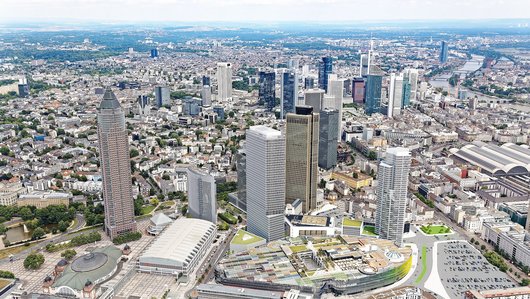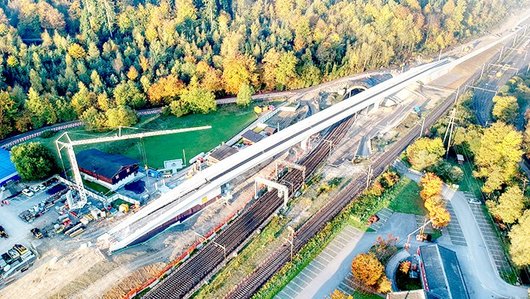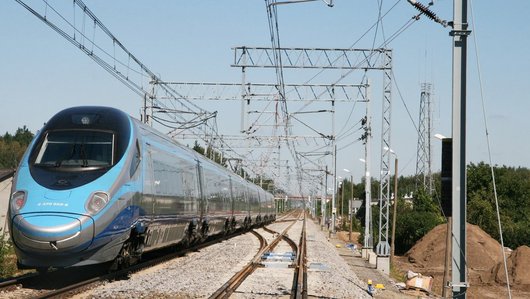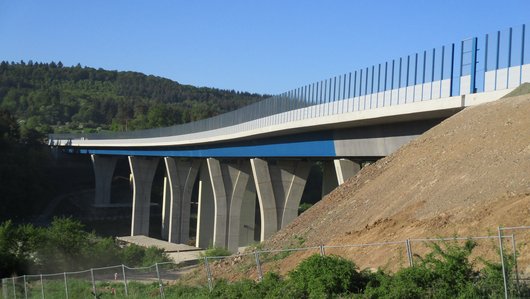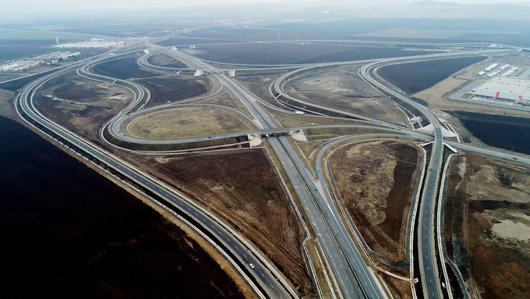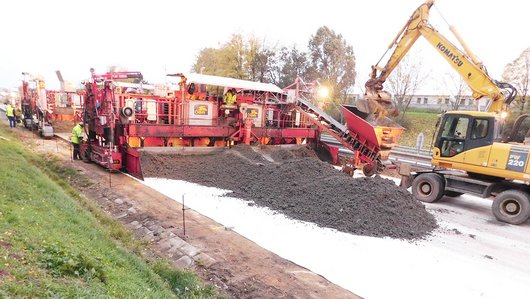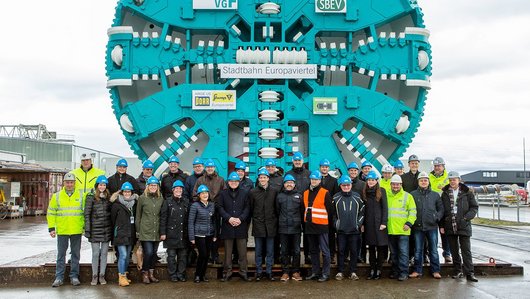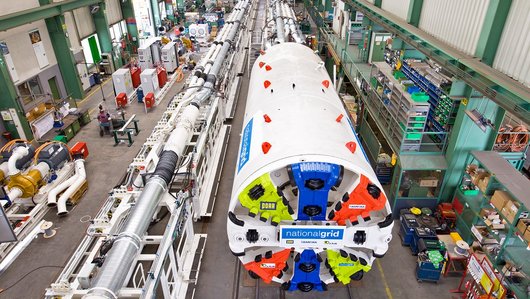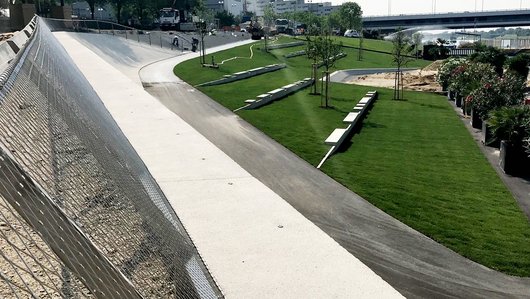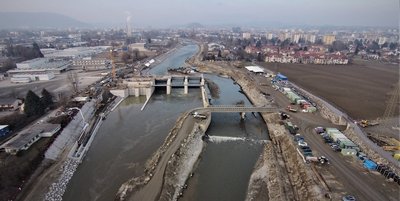
Mur power station, Graz
The new power plant PORR is building on the River Mur in Graz will supply clean energy to Styria’s capital city.
A central reservoir channel forms a key element of the contract. This is a relief channel that can support the city’s sewer system when it is overloaded by heavy rain, keeping the Mur clean and thus ensuring a marked improvement in water quality.
-
EmployerEnergie Steiermark Green Power GmbH
-
ContractorARGE Murkraftwerk Graz PORR-Granit-Steiner
-
Order typeBaumeisterleistungen
-
Project typeCivil engineering/infrastructure, power station construction
-
Project scopeWeir construction including reservoir channel and ecological mitigation scheme
-
Construction start01/2017
-
Construction end12/2020
Background
The Mur power station in Graz is one of the most important energy projects in progress in Styria. The 80 million euro project is being coordinated with the city of Graz to supply Styria’s capital with clean energy. Now that it has its own green energy generated by hydroelectric power, Graz will no longer need to import electricity from nuclear power stations abroad. The new, green power station will also emit considerably less CO2 than other power stations. The public tender for the power station and a linked central reservoir channel was issued back in 2015. A long, intensive negotiation process followed before the Murkraftwerk Graz consortium, comprising PORR, Granit and Steiner, was awarded the contract in December 2016.


Preparing the site and diverting the Mur
Work started immediately the contract was awarded: in January 2017, project teams began clearing the river banks and setting up construction site facilities. These included a gravel processing plant and a concrete mixing plant, containers for offices, foremen and site crews, and large machinery areas. Once this was done, the gas, water and electricity lines were relocated and diversions set up for the footpaths and cycle paths. At the same time, work began on the temporary diversion of the Mur itself, skirting the construction pit where the weir and sealing work would be done. The Mur was diverted right on schedule at the beginning of summer 2017 and as soon as the sealing work was completed, work could begin on building the power station.
The central reservoir channel
The power station wasn’t the only construction work underway: in autumn 2017, project teams began excavating the new central storage channel. At the time, the sewerage system in the city of Graz had become unable to handle the volumes of water following heavy rainfall. After a downpour, overflow channels would run directly into the Mur, contaminating the river with faecal matter and heavily polluted surface runoff. The new collector channel has resolved this this problem. Mixed water overflows are directed through relief structures into the new 8.0m wide and 3.5m high collector channel running beneath the bed of the Mur, bypassing the weir, and joining the river about 2km downstream. This new reservoir channel has a total length of 5km and a reservoir volume of around 60,000m³. Once the rainfall has eased, the collected water is gradually fed to the Graz sewage treatment plant. As a result, faecal matter is properly filtered and no longer flows straight into the river – ensuring a significant improvement in the quality of the Mur water.
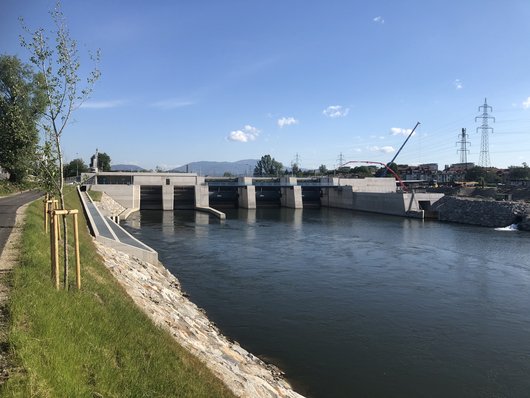

Sealing and ecological mitigation
Sealing activities for the upstream dams began while work continued in the central reservoir channel. According to the plans, the dams were to be sealed with membrane walls up to 30 m. However, since – for reasons that have not yet been resolved – this proved impossible, the majority of the sealing was completed using the jet grouting method. In parallel with the sealing work, the “Rudersdorf” riverside biotope was developed – an ecological mitigation zone comprising a 1.8ha riparian woodland with 7,000 trees and a stream running into the Mur. While one team was busy on the biotope, another project team was working on deepening the river bed, a scheme designed to maximise the effective drop height for the Mur water in the weir.
All the spoil from the construction site, totalling around 1,000,000m³, was transported to the gravel processing plant by articulated dump truck and processed into various grain sizes for recycling.
Deepening the river bed
The river bed was deepened by an average of 2.5m using a backhoe excavator, and around 250,000m³ of spoil was transported to the gravel processing plant with articulated dump trucks and processed into various grain sizes for recycling. The majority of this material was used for concrete production for the weir and central reservoir channel. The weir construction work was running to schedule, and the two Kaplan turbines were installed and the Mur restored to its usual course in summer 2019. The power station started up in October 2019 and the 17.7 megawatt plant is now feeding 82 million kilowatt-hours of green energy into the grid each year, supplying the energy requirements of over 45,000 people in Styria’s capital city – or the consumption of over 20,000 electric cars – and reducing harmful emissions by over 60,000 tonnes of CO2.
Additional contract
In addition to building the power station and the central reservoir canal, the consortium was contracted by Holding Graz to create a shallow water zone in Graz’s riparian zone. The new “Murarena” is a 6,000m² recreation zone for the Graz residents, boasting generous park areas and benches and a sports field. Once the new zone had been planted out, a rest and maintenance period followed to allow the new plants to establish. In spring 2020, the Murarena was opened to the public and has proved popular with the locals.
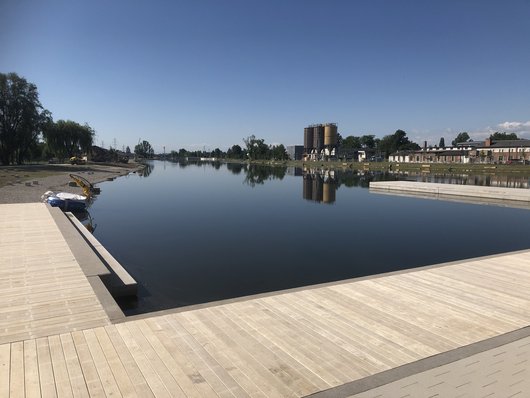

Summary
The Covid-19 crisis caused minor delays to completion of the central reservoir channel and various project-related activities included in the tender that will transform the area around the power station into an attractive recreation zone for local residents. Completion is now scheduled for the end of 2020.
Technical data
-
Length of central reservoir channel5,000 m
-
Volume of central reservoir channel60,000 m³
-
Volume of underwater deepening250,000 m²
-
Trees planted to date as compensation measures10,000

